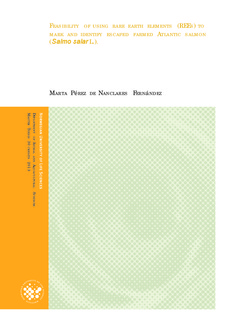Feasibility of using rare earth elements (REEs) to mark and identify escaped farmed Atlantic salmon (Salmo salar L.)
Master thesis
Permanent lenke
http://hdl.handle.net/11250/186231Utgivelsesdato
2014-02-11Metadata
Vis full innførselSamlinger
- Master's theses (IHA) [318]
Sammendrag
The development of a marking technique which could be efficiently used to mass-mark
different groups of salmonids, would be a great tool for fisheries and aquaculture
management. The present study was conducted in order to evaluate a series of rare earth
elements (REEs) as potential markers in scales of Atlantic salmon (Salmo salar L.) by
addition of these elements to the feed. The results demonstrated that the five tested
elements were clearly incorporated into the scales of the fish fed the supplemented diets.
Fish marked with these elements can be successfully identified by chemical analysis of
the scales by inductively coupled plasma mass spectrometry (ICP-MS). The elemental
levels (except for lanthanum) in the scales of the treated fish were still significantly
higher than those of the untreated fish 2 months after the labeled diets were
administered, although these levels were markedly lower than the ones present right
after the labeling. A long-term monitoring of the chemical concentrations in the scales is
required to study the longevity of the induced marks.
The background levels of the tested markers and some other elements were also
analyzed and found to show interesting patterns. It is suggested that, in some instances,
the natural chemical fingerprint of the scales may be enough to distinguish among fish
groups. However, more research about the elemental background levels in the scales is needed in order to conclude with this.
Beskrivelse
The development of a marking technique which could be efficiently used to mass-mark
different groups of salmonids, would be a great tool for fisheries and aquaculture
management. The present study was conducted in order to evaluate a series of rare earth
elements (REEs) as potential markers in scales of Atlantic salmon (Salmo salar L.) by
addition of these elements to the feed. The results demonstrated that the five tested
elements were clearly incorporated into the scales of the fish fed the supplemented diets.
Fish marked with these elements can be successfully identified by chemical analysis of
the scales by inductively coupled plasma mass spectrometry (ICP-MS). The elemental
levels (except for lanthanum) in the scales of the treated fish were still significantly
higher than those of the untreated fish 2 months after the labeled diets were
administered, although these levels were markedly lower than the ones present right
after the labeling. A long-term monitoring of the chemical concentrations in the scales is
required to study the longevity of the induced marks.
The background levels of the tested markers and some other elements were also
analyzed and found to show interesting patterns. It is suggested that, in some instances,
the natural chemical fingerprint of the scales may be enough to distinguish among fish
groups. However, more research about the elemental background levels in the scales is
needed in order to conclude with this.
